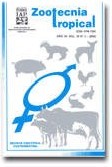
|
Zootecnia Tropical
Instituto Nacional de Investigaciones Agrícolas Venezuela
ISSN: 0798-7269
Vol. 23, No. 1, 2005, pp. 61-68
|
 Bioline Code: zt05006
Bioline Code: zt05006
Full paper language: English
Document type: Research Article
Document available free of charge
|
|
|
Zootecnia Tropical, Vol. 23, No. 1, 2005, pp. 61-68
| en |
In vitro phytase activity of rumen microorganism and in situ degradation of fibrous substrate in sheep fed different feeding regimes.
Susmira Godoy y Claudio F. Chicco
Abstract
Rams provided with rumen fistulae were fed diets containing three levels of forage/concentrate ratios: high (F, 100%)), medium (FC, 50%) and low forage level (FCC, 20%). An in vitro method was used to determine phytase activity, and an in situ suspension of nylon bags, containing grounded forage, to measure degradability of dry matter (MS), organic matter (MO) and residual crude protein (PC) and phosphorus (P). In addition, pH was measured in rumen content. Phytase activity increased with the addition of concentrate, with values of 0.232, 0.229 and 0.313 U/kg, respectively for F, FC and FCC, being the latter higher (P<0.05). No differences were found in MS and MO degradability. Proteolysis was enhanced with the addition on concentrate, being this higher (P<0.05) for FCC. Rumen pH was decreased by the addition of concentrate (P<0.05), reaching values of 6 approximately, at 8 hours of incubation. Residual P was higher (P<0.05) in FCC treatment. It is concluded that feeding forages with the addition on concentrate results in an increment o microbe phytase activity in the rumen, associated with changes in the fermentation pattern, apparently promoting microorganisms adapted to more acid ruminal environment.
Keywords
Phytase activity, rumen microbiota, substrate digestion fiber, sheep.
|
| |
| es |
Actividad fitásica in vitro de los microorganismos del rumen y degradación in situ de un sustrato fibroso en ovinos alimentados con diferentes regímenes
Susmira Godoy y Claudio F. Chicco
Resumen
Carneros provistos de fístula ruminal fueron alimentados con tres dietas con diferentes relaciones forraje/ alimento concentrado: alta (F, 100%): mediana (FC, 50%) y baja en forraje (FCC, 20%). Se utilizó un sistema in vitro para medir la actividad fitásica, y suspensión in situ de bolsas de nylon con forraje molido, para determinar la degradabilidad de la materia seca (MS), materia orgánica (MO) y proteína (PC) y fósforo (P) residual. Adicionalmente, se determinó el pH del contenido ruminal. La actividad fitásica aumentó significativamente para los tratamientos con suplementación, con valores de 0,232; 0,229 y 0,313 U/kg para F, FC y FCC, respectivamente, siendo FCC mayor (P<0,05). No se observaron cambios aparentes en la degradación de la MS y MO. La proteólisis aumentó con la adición del concentrado, con valores mas elevados (P<0,05) para FCC. El P residual fue mayor (P<0,05) para el tratamiento FCC (50,7%). El pH disminuyó (P<0,05) con las dietas con concentrados, alcanzando valores cercanos a 6, a las 8 horas de incubación. Se concluye que la suplementación con concentrados aumenta la actividad fitásica en el rumen, con modificaciones del patrón de fermentación de la microbiota, aparentemente a favor de los microorganismos adaptados a condiciones mas ácidas en el ambiente ruminal.
Palabras-clave
Actividad fitásica, microbiota ruminal, degradación substrato, fibra, ovinos.
|
| |
© Copyright 2005 - Zootecnia Tropical
Alternative site location: http://www.sian.inia.gob.ve/repositorio/revistas_ci/ZootecniaTropical/ztindice.htm
|
|
